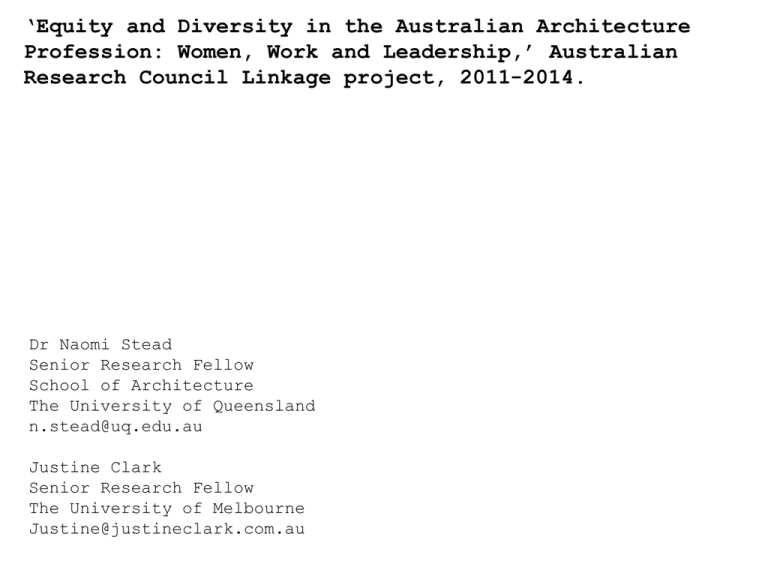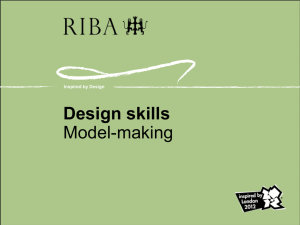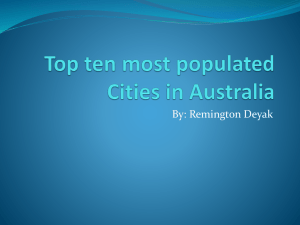Equity and Diversity in the Australian Architecture Profession
advertisement

‘Equity and Diversity in the Australian Architecture Profession: Women, Work and Leadership,’ Australian Research Council Linkage project, 2011-2014. Dr Naomi Stead Senior Research Fellow School of Architecture The University of Queensland n.stead@uq.edu.au Justine Clark Senior Research Fellow The University of Melbourne Justine@justineclark.com.au Women Architects in Australia: What we Know 2011 Census: Architects Australia Full Time, Income by gender 35.0 30.0 25.0 20.0 15.0 Female Male 10.0 5.0 0.0 Source: Analysis by Dr Julie Connolly based on ABS, 2011 Census of Population and Housing, Australia. Women Architects in Australia: What we Know At School: There are 18 Architecture Schools in Australia. In 2011 there were 9222 students in total across the two degrees. • 42% of them were women. Source: Summary by Gill Matthewson and Kirsty Volz. Statistics extracted by Carol Capp, National Education Co-ordinator, AIA, from Australian Institute of Architects, “Architecture Schools of Australasia” 2000 to 2011 editions, November 2011. Supplemented by data from the 2012 edition and 1987 to 1999 editions supplied by the AIA. Note: data pre-2000 is less reliable than post 2000 as reporting protocols differed between Schools. Women Architects in Australia: What we Know At School: The proportion of women graduating from Architecture Schools increased rapidly from the mid-eighties to the mid-nineties. It then levelled off. From 1990-1999 women averaged 40% of all graduates. From 2000-2010 this increased to 41% of all graduates. At the end of 2010, 975 students graduated, 427 of whom (44%) were women. Graduates from all Schools of Architecture, 1987-2010. Data ‘smoothed’ by taking averages for previous three year period. Source: Gill Matthewson and Kirsty Volz. Women Architects in Australia: What we Know At work: 2006 Census: Total number of architects 13,285. Female 3089 (23.3%) Male 10196 (76.7%) Percentage of Women Architects By Age Group - according to Census Data Source: Analysis by Gill Matthewson based on ABS, 2006 Census of Population and Housing, Australia. Women Architects in Australia: What we Know Registered Architects - 21% At work: Registration. • If we take registration as a measure of women’s participation in the profession, there are 10,516 registered architects in the Commonwealth and 2,286 of them are women (21.7%). • In 2004, women were 14.3% of registered architects. • Although there has been a significant increase in numbers and percentages, the figures are lower than what might be projected from the graduation rates, and lower than the professions of law (46%) and medicine (36%) with which architecture is often compared. Source: Architecture data obtained from individual State Architects Registration Boards in 2012 and by direct counts of some Registers. Law data from Heather Moore and Kate Potter, "Advancement of Women in the Profession," The Law Society of New South Wales (2011). Medicine data from ABS, http://www.abs.gov.au/ausstats/abs@.nsf/mf/4819.0. % men % women Medical - 36% % men % women Solicitors - 46% % men % women Women Architects in Australia: What we Know At work: Membership of the Australian Institute of Architects • • • • In 2012, there were 11,738 members of the Institute 3,020 were women This constitutes 26% of Institute members However, there are different categories of membership and the pattern of membership differs quite markedly for each gender Male Female Affiliate Affiliate Graduate Graduate Student/SONA Student/SONA Honorary & Fellow Honorary & Fellow Member Level 1 Member Level 1 Member Level 2 Member Level 2 Membership Categories By Gender Source: Analysis by Gill Matthewson, based on data provided by the Institute of Architects national office, 30 March 2012. Women Architects in Australia: What we Know Gender-based pay disparity: Graduate Salaries Reports • • • • • • 2010 Graduate Careers Australia Graduate Salaries Report places women graduates in architecture and building on salaries averaging 88% of male average. The gap between men and women’s median graduate starting salaries in architecture and building was larger than any other industry surveyed This would have young women in 2010 starting out on $5,000 a year less than their male counterparts. In 2011 the gap increased to $7000; a pay gap of 14%, up from 12%. However, upon investigation the above figures are unreliable, due to grouping of architecture with other disparate fields. Analysis on architects alone demonstrates that the startingsalary pay gap is likely to be closer to 6.25% • There is still an issue, and architecture is still located in an industry with marked pay disparity • 2006 Census data shows women more highly represented in part time work (28.63% of females, 10.85% males) Source: Analysis by Justine Clark, ‘Architecture, Gender, Economics,’ Architecture Australia, May 2012. Pay inequity in architecture Pay inequity in architecture Pay inequity in architecture Australian Research Council Linkage Funded project, ‘Equity and Diversity in the Australian Architecture Profession: Women, Work and Leadership,’ 2011-2014. the issues: × Women are under-represented in the architecture profession in Australia × This is particularly apparent at senior levels × Proportion of female graduates is close to parity, but women are not advancing in sufficient numbers × Women architects tend to follow ‘atypical’ career paths × Trained women tend to leave, step sideways, or not return from a break × There is evidence of gender-based pay inequity × There is evidence of the sidelining of architects working part time × Low pay, long hours, and difficulty in reconciling professional and family life are also problems for men in architecture, but they impact in different, specific, and compounded ways for women Australian Research Council Linkage Funded project, ‘Equity and Diversity in the Australian Architecture Profession: Women, Work and Leadership,’ 2011-2014. project partners research team × Dr Naomi Stead ×× Senior Research Fellow, School of Architecture, The University of Queensland × Professor Julie Willis ×× Faculty of Architecture, Building and Planning, The University of Melbourne × Professor Sandra Kaji-O‘Grady ×× School of Architecture, The University of Queensland × Professor Gillian Whitehouse ×× School of Political Science and International Studies, The University of Queensland × Ms Justine Clark ×× Senior Research Fellow, The University of Melbourne × Dr Karen Burns ×× Faculty of Architecture, Building and Planning, The University of Melbourne × Dr Amanda Roan ×× School of Business, The University of Queensland × Ms Gill Matthewson ×× PhD candidate, School of Architecture, The University of Queensland × Kirsty Volz, Claire Humphreys, Neph Wake, Byron Kinnaird, Kelly Adams, Luc Bourgeois, Mark Keogh ×× Research Assistants research outcomes and applications www.archiparlour.org @_Parlour • Parlour website • Industry surveys • Guides to Equitable Practice • Industry consultation on equity policy and practices www.archiparlour.org @_Parlour 1 Country / Territory 3. 4. 5. • At September 2013, 39,093 visitors • 69,349 visits, • From 156 countries, 2661 cities Visits Pages / Visit Avg. Visit Duration % New Visits Bounce Rate 69,349 2.46 00:02:56 56.43% 64.72% (69,349) Site Avg: 2.46 (0.00%) Site Avg: 00:02:56 (0.00%) Site Avg: 56.35% (0.15%) Site Avg: 64.72% (0.00%) 45,122 2.76 00:03:26 47.71% 60.74% 7,251 1.94 00:02:01 76.35% 71.76% 2,975 1.84 00:01:55 73.01% 72.00% New Zealand 2,092 2.60 00:03:05 59.18% 59.03% Canada 1,265 1.75 00:02:10 78.50% 74.23% • 2. Launched May 11 2012, Brisbane 45,122 Parlour: Women, Equity, Architecture 1. • Launched May 11 2012 % of Total: 100.00% Australia • As of yesterday: 39,093 visitors United States •United Kingdom 69,349 visits, • From 156 countries, 2661 cities Two industry surveys: • ‘Where do all the women go?’ June to August 2012 • 1377 responses • ‘…and what abut the men?’ December 2012 to Feb 2013 • 918 responses Parlour Guides to Equitable Practice in Architecture • Closely tailored to architecture • Informal, accessible tone • Addressed equally to employers and employees • Parlour as ‘one stop shop’ • Accompanied by fact sheets (in development) • Two topics yet to be defined Tailoring resources to an architectural audience Challenges and opportunities for change – culture and institutions • • Strong sense of professional identity: as liberal, meritocratic, dedicated to the common good This leads to defensiveness and denial of any gender equity problem, but also some willingness to address it (‘but we’re the good guys!’) • There are powerful processes of enculturation and socialisation: the resulting tight community is inclusive of women architects, but for this reason there is wariness about gender distinction and the so-called ‘gender card’ • The Australian Institute of Architects is a membership organisation, hence inherently limited in the ‘carrots’ and ‘sticks’ it can employ • Low incidence of overt discrimination (with the notable exception of staff returning from parental leave, wishing to work part time) Nevertheless equity is still largely seen as a niche or ‘women’s issue’ Perception that if there is pay inequity it’s because ‘women don’t ask’ • • Challenges and opportunities for change - informality • Exceptionalist discourses: the idea of architecture as entirely unique and unlike any other profession – hence resources which are generic or developed for other industries are not seen to be applicable • Architecture as creative industry: practices (especially small ones) have a disposition to be informal, anti-HRM, anticorporate, anti-profit, somewhat cultic (‘we’re all just friends here’) Surprisingly high levels of ignorance about legal responsibilities in regard to equity (‘need to know’ basis) Embrace of ‘creative chaos’: informality leads to high levels of flexible working, but also many instances of poor organisation and management, financial and otherwise • • • • • Rewards are seen to come in forms other than money: good work, interesting work, interesting colleagues, public good; this can be inadvertently inequitable There is resistance to the very idea of ‘career progression’ Sense of ‘vocation’: requires demonstration of commitment through very long hours worked (‘part time workers aren’t ‘real’ architects’) Challenges and opportunities for change – industry and economics • • • • The industry is highly competitive and powerfully affected by economic cycles, which has direct effects on equity (‘easier to be equitable in the boom times’) The ‘business case’ for equity thus shifts markedly in different economic circumstances Pay equity is linked to a whole range of other complex issues – long hours culture, marginalisation of part time workers, difficulties in returning from career break, etc In summary: there is goodwill but ignorance, hand-wringing but helplessness. There may be an increasing acceptance that the issue is real. Organised systems which might redress inequity are not well subscribed, indeed there is an active resistance to such systems. Some prospect for slow and incremental change if appropriate resources can be offered to both employers and employees.










